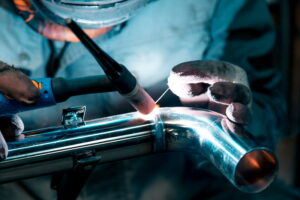
Tungsten welding is one of today’s industries’ most advanced welding techniques. It is known for producing high-quality, precise welds vital for applications with critical weld integrity. It is commonly used to fabricate aerospace components, pressure vessels, and critical components in the automotive industry. While this type of welding requires high skill and practice, it offers unmatched precision and control over the welding process. Tungsten Inert Gas (TIG) welding is a highly versatile process of welding that uses an electrode which is a non-consumable tungsten, to create a weld. It is a popular method welders use to create precise and high-quality welds. This article explores the basics of tig welding, including the essential techniques and equipment involved, to help you better understand this advanced welding process.
What is Tungsten Welding?
- The tungsten electrode is held in a welding torch, and the welder manually feeds the filler metal into the weld pool.
- This process is slow and requires precision but produces a high-quality weld. It is commonly used in applications where the quality of the weld is crucial.
- However, tungsten welding requires a high degree of skill and practice to master. The welder must maintain a steady hand and precise movements to control the heat input and feed the filler metal into the weld pool.
- Also, proper gas coverage is essential to prevent atmospheric contamination of the weld pool.
- Tungsten welding is a slow and precise process requiring patience, skill, and practice. But when performed correctly, it can produce high-quality, durable, and reliable welds.
Welding Techniques
Inert gas welding requires a high degree of skill and practice. The following techniques are essential to master to ensure high-quality welds:
- Gas welding requires high proficiency and practice to achieve high-quality welds.
- The torch should be held at an angle of 15 to 20 degrees from the workpiece to ensure proper gas coverage and heat distribution.
- Feeding the filler metal into the weld pool at the correct rate is crucial for achieving top-quality welds.
- The filler metal should be held at an angle of 10 to 15 degrees from the torch.
- Consistent welding speed is essential for achieving high-quality tungsten inert gas welds, a slow process requiring patience and precision.
- Tungsten inert gas welding requires a shielding gas to protect the weld pool from atmospheric contamination.
- Gas coverage should always be maintained during welding to ensure proper shielding.
- By mastering these techniques, welders can produce high-quality welds that are durable and reliable.
Tungsten Welding Equipment
Tungsten inert gas welding requires specific equipment to create a high-quality weld. The following equipment is necessary to perform the welding:
- Tungsten Electrode: Tungsten electrode is held in the welding torch and supplies the electrical current for the welding process.
- Torch: The welding torch holds the tungsten electrode and feeds the filler metal into the weld pool. Additionally, the torch controls the shielding gas flow during the welding process.
- Filler Metal: To create a weld, the tungsten inert gas welding process requires filler metal. The welder feeds this metal into the weld pool, which must be compatible with the welded base metal.
- Shielding Gas: A shielding gas is necessary during tungsten insert welding to protect the weld pool from contamination from the atmosphere. The most commonly used shielding gas for Tungsten welding is argon.
- Power Source: The tungsten insertion gas process of welding requires a power source to generate the electrical current needed for welding. The power source must produce a stable arc to achieve a high-quality weld.
Conclusion
A precise and versatile welding process tig welding commonly used in the aerospace, automotive, and industrial manufacturing industries. To ensure a high-quality weld, the welder must master the proper techniques and use the necessary equipment. You can create high-quality welds that meet your needs by understanding the basics of tungsten inert gas welding.
Author Name – Ramandeep